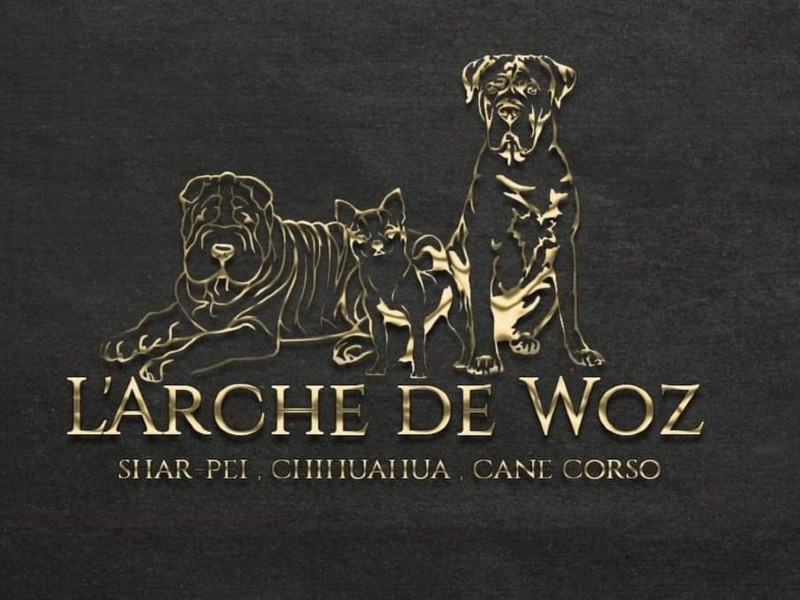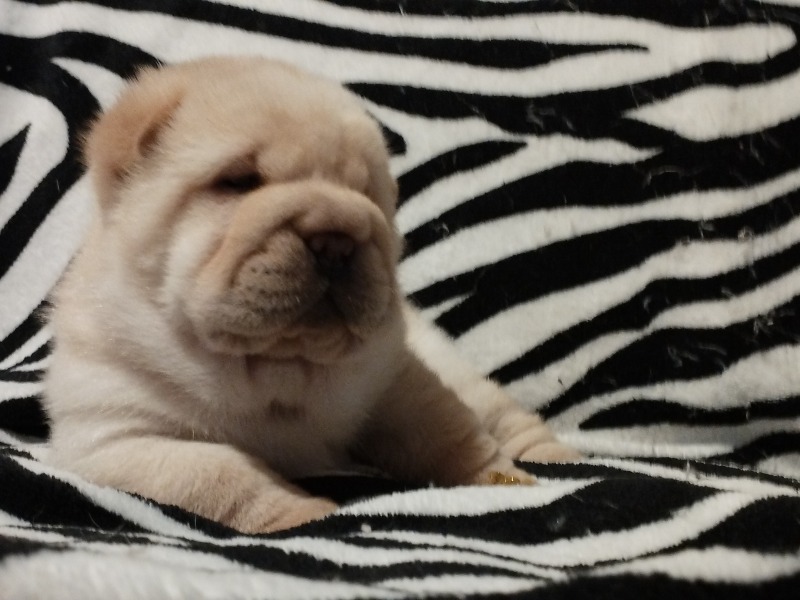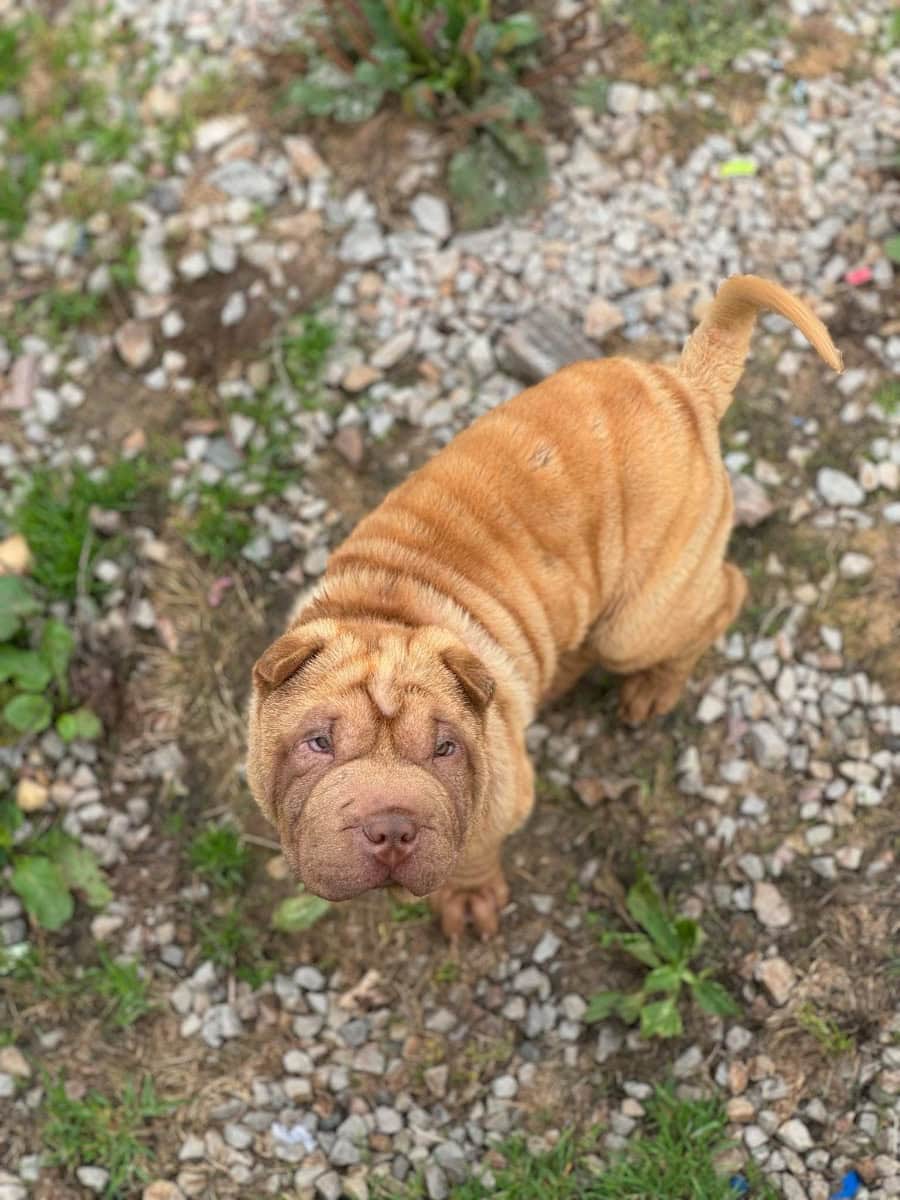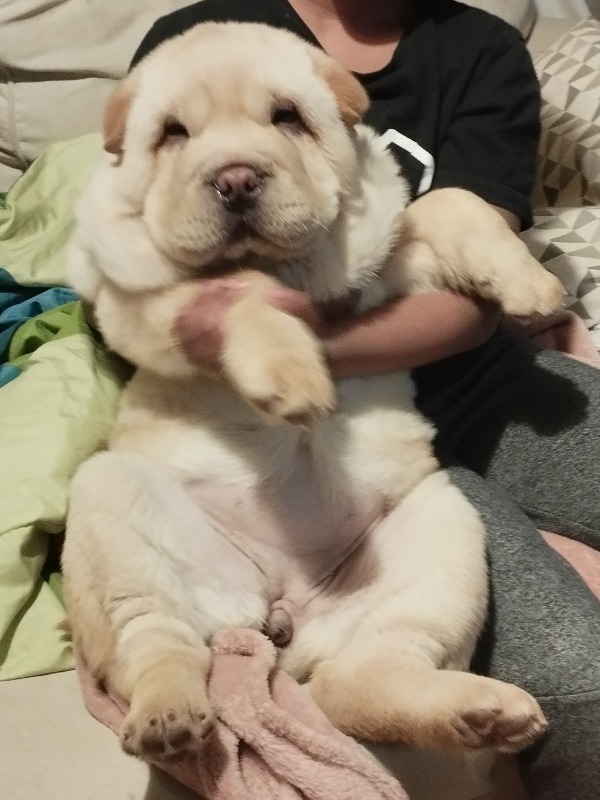Shar-pei
Autres noms : Cantonese shar-pei, Chinese fighting dog
Discover the Shar-Pei, a unique dog breed with its wrinkled skin and loyal character. Originating from China, this affectionate companion is both protective and calm, making it perfect for families and dog lovers. Learn more about its needs, training, and temperament.
Awareness of acquiring an animal
Adopting or breeding a dog is a responsibility that must be carefully considered. Dogs are loyal companions that require time, attention, and constant care. Whether for leisure, passion, or professional breeding, it is crucial to understand the specific needs of each breed. Provide them with a loving and stimulating environment, and avoid any impulsive acquisition that could harm their well-being. Be a vigilant and committed owner for a happy and healthy companion.
To learn more about animal welfare, we invite you to consult our FAQ by clicking the button below:
Origins and history
The Shar-Pei is a dog breed that originated in China, with roots dating back several thousand years. Initially, it was used as a working dog, guarding farms and hunting animals. Its unique appearance, characterized by excessive folds and loose skin, gave it an advantage in fights, a practice that thrived during the Han dynasty.
In the 1960s, the situation for the Shar-Pei began to deteriorate due to the Cultural Revolution in China. People who owned these dogs started to abandon them, and the breed was on the verge of extinction. However, breeders and enthusiasts from other countries, particularly in Hong Kong, worked to preserve the breed. Thanks to their efforts, the breed was revived in the 1970s and 1980s, gaining popularity around the world, especially in the United States.
The Shar-Pei is now known for its calm and reserved temperament, becoming a sought-after companion. Its physical uniqueness and fascinating history make it a beloved breed among dog lovers.
Physical characteristics
The Shar Pei is a dog breed easily recognizable due to its unique appearance. One of its most remarkable characteristics is its wrinkled skin, which gives it a distinctive and almost creased look. These wrinkles can vary in depth and number, but they are usually more pronounced on the head, neck, and body. This skin is also quite thick, providing additional protection against the elements.
In terms of size, the Shar Pei is a medium-sized dog, generally measuring between 44 and 51 cm at the shoulder. Its weight ranges from 18 to 30 kg, depending on the lineage and gender. Its musculature is robust, giving it a solid appearance. The head of the Shar Pei is broad and square, with a flat skull and a short muzzle, which enhances its unique look.
The eyes are almond-shaped and dark in color, often sunken, which can give it a distinctive gaze. The ears are small and folded, pointing forward. The tail is thick at the base and curls over the back. Its coat is short and rough, available in a variety of colors, ranging from solid shades to more complex hues. These physical characteristics make the Shar Pei both a fascinating and impressive dog.
Character
The Shar-Pei is a dog breed that stands out for its unique appearance, particularly its distinctive skin folds. This dog is known for its loyal and affectionate temperament. Owners of this breed often testify to the great affection these animals show to their families, making them excellent companions.
However, the Shar-Pei also has an independent nature. This can make training a bit more complex, as these dogs can be stubborn. It is essential to adopt a positive and consistent training approach to achieve good results. Early socialization is also crucial to prevent reserved or distrustful behaviors towards strangers.
Moreover, this breed can be quite reserved, especially with unfamiliar people. This makes them good guard dogs, as they are vigilant and protective. Despite this caution, the Shar-Pei is generally sociable with the members of its household and gets along well with children, as long as it has been properly socialized. The balance between protection and sociability makes it an interesting and endearing companion.
Life expectancy
The life expectancy of a Shar-Pei is generally between 8 and 12 years. Several factors influence this lifespan, including genetics, care, and living conditions. It is important to note that some individuals may live longer if they benefit from good overall health and regular veterinary check-ups.
Shar-Peis are prone to certain hereditary conditions, including eye and skin problems. These conditions can sometimes affect their quality of life and, consequently, their life expectancy. A balanced diet, regular exercise, and attention to signs of illness can help minimize these risks.
Emotional well-being also plays a crucial role. Dogs that receive adequate socialization and positive training tend to live longer and have better mental health. By taking care of all these aspects, owners can hope to provide their companion with a long and fulfilling life.
Exercise and activity needs
The Shar-Pei is a dog breed that, despite its distinctive appearance, has specific exercise needs. Although they are not tireless runners, they require regular physical activity to maintain good mental and physical health. Generally, one or two daily walks of about 30 minutes are recommended. This allows the dog to expend its energy and explore its environment.
In addition to walks, the Shar-Pei enjoys mentally stimulating games. Activities such as toy hunting or participating in obedience games can be beneficial. These exercises not only promote their agility but also strengthen the bond between the dog and its owner. A lack of activity can lead to boredom, which may result in behavioral problems.
It is essential to adjust the intensity and duration of exercise based on the dog's age and health. Young Shar-Peis may need more activity, while older dogs may benefit from shorter and less intense sessions. In summary, a balanced routine of physical and mental exercise is crucial for the well-being of Shar-Peis.
Recommended diet
The diet of Shar-Pei dogs should be carefully balanced to meet their specific needs. These dogs, known for their wrinkled skin and muscular build, require food that is rich in high-quality protein. This promotes healthy muscle development and helps maintain their ideal weight.
It is recommended to prioritize kibble specifically formulated for large breed dogs. The protein content should be at least 20-30%, while fats should represent approximately 8-15% of their diet. Omega-3 and omega-6 fatty acids are essential for keeping their skin healthy and preventing dermatological issues, to which this breed is prone.
Furthermore, it is important to incorporate complex carbohydrates, such as brown rice or sweet potatoes, which provide lasting energy. Avoid artificial ingredients and meat by-products, as they can harm your pet's health.
For portioning, it is best to divide meals into two or three feedings per day to avoid the risk of gastric torsion, a potential issue in this breed. Remember to consult a veterinarian for advice tailored to your dog's age, size, and physical activity.
Training and obedience
The Shar-Pei is a distinctive breed with a strong character. For successful training, it is crucial to start at a young age. Socialization is essential to avoid fearful or aggressive behaviors. Expose him to different people, animals, and environments to help him develop a balanced and confident attitude.
Training should be based on positivity and reward. The Shar-Pei can be stubborn, which requires patience and consistency. Use treats, praise, and play as motivation. Avoid punitive methods, which can create fear and stress, making training even more difficult.
Exercise is also essential. Although this breed may appear calm, it needs regular activities to stay healthy and fulfilled. Daily walks and stimulating play will contribute to its physical and mental well-being. Finally, stay attentive to its health, as the Shar-Pei can be prone to certain illnesses. Regular veterinary check-ups are therefore recommended.
Behavior with children
The behavior of Shar-Pei dogs with children can vary depending on several factors, including socialization, training, and the individual temperament of each dog. In general, these dogs are known for being loyal and protective of their family. This often includes a good relationship with children, especially if they have been exposed to them from a young age. Early and positive socialization is essential to ensure harmonious coexistence.
However, it is important to monitor interactions between Shar-Peis and young children. Their sometimes reserved nature and sensitivity to sudden movements can make them feel threatened in certain situations. Children should be taught how to interact respectfully with the dog to prevent any defensive or anxious reactions from the latter.
In terms of play, these dogs can be playful, but their tolerance threshold may be more limited than that of other breeds. Therefore, it is recommended to supervise play sessions and set clear boundaries for both parties. In summary, with proper training, adequate socialization, and appropriate supervision, a Shar-Pei can be a loving and protective companion for children.
Compatibility with Other Animals
The Shar-Pei is a dog with a unique character that can adapt to different home environments. However, its compatibility with other pets depends on several factors, including its temperament, early socialization, and training.
In general, the Shar-Pei can get along well with other dogs if it is properly socialized from a young age. Gradual exposure to various animals can help reduce defensive or hostile behaviors. However, it is essential to supervise initial interactions and ensure they are positive to prevent incidents of dominance or aggression.
Regarding other pets, such as cats or rodents, the independent temperament of the Shar-Pei may make it less inclined to regard them as playmates. A careful introduction is crucial. It is imperative to monitor these interactions and not allow the Shar-Pei to explore freely without control, especially if the other animal is small.
Ultimately, proper socialization and appropriate training from an early age are key to ensuring a harmonious coexistence between a Shar-Pei and other household pets. A clear framework and positive experiences promote a peaceful cohabitation.
Grooming needs
Grooming and maintenance of Shar-Pei dogs require special attention due to their wrinkled skin. First of all, it's essential to perform regular brushing. Generally, two to three times a week is sufficient to remove dead hair and prevent tangles. This also helps to keep the skin healthy and improve blood circulation.
Next, the skin folds are areas prone to accumulating moisture and dirt, which can lead to skin infections. Therefore, it is crucial to clean these folds with a damp cloth and use a specific powder to dry them. This daily hygiene helps to prevent irritation and infections.
Regarding bathing, it is recommended not to do it too frequently, about every two to three months, so as not to alter the natural oils in their skin. Lastly, attention to dental care and ear health is also necessary, ensuring regular brushing and checking for the absence of wax or irritation. A good diet and regular exercise complete their maintenance.
Health
The Shar-Pei is a unique dog breed, best known for its wrinkled appearance. However, despite its undeniable charm, this breed has several specific health concerns that are essential to be aware of.
First of all, skin issues are common in Shar-Peis due to their wrinkles. These folds can retain moisture and promote the accumulation of bacteria, leading to skin infections. Regular care is crucial to maintain good hygiene, especially by gently cleaning the folds and drying sensitive areas.
Next, the breed is predisposed to certain eye conditions, such as entropion, where the eyelids fold inward, causing irritation. This may require surgical intervention to correct the problem and prevent complications.
Finally, joint health should also be monitored. Shar-Peis can suffer from hip dysplasia due to their physical build. Regular veterinary check-ups and appropriate physical activity are vital to prevent these issues and ensure optimal well-being for these dogs.
Environment and habitat
The Shar-Pei is a dog breed originating from China, characterized by its wrinkled skin and distinctive facial features. This dog is particularly well-suited to a domestic environment where it can receive constant attention and appropriate care. It thrives within a family setting and requires early socialization to behave harmoniously with other animals and people.
Regarding its habitat, the Shar-Pei is adaptable but prefers a space that allows it to move freely, such as a fenced garden. Although it needs daily exercise, short regular walks are usually sufficient. The indoor environment should be comfortable and secure, as this breed can develop anxiety issues if it feels isolated.
Its wrinkled skin requires special attention to hygiene to prevent infections. Regular grooming, along with frequent inspections of the skin folds, is essential to ensure its health. In summary, the well-being of this breed depends on both good socialization and a well-maintained, secure environment.
Name ideas
Choosing a name for a shar-pei, like for any pet, is a crucial step that reflects not only the personality of the animal but also the relationship you wish to establish with it. A good name should be easy to pronounce, relatively short, and clearly audible so that the dog can recognize it. It is also helpful to choose a name that does not sound similar to common commands (like “sit” or “no”) to avoid any confusion while training. Additionally, consider the distinctive physical features and the unique nature of the breed, with its characteristic folds and often gentle yet reserved temperament.
To accompany your shar-pei throughout its life, here are some name suggestions that might be suitable:
Luna, Pli, Pacha, Koda, Moka, Zola, Nugget, Bambi, Sumo, Pudding, Atlas, Tango, Sushi, Nibbles, and Biscuit.
These names highlight both the unique beauty of shar-peis and their endearing personalities, while remaining simple and memorable. Don’t hesitate to try out a few of these names to see which one suits your companion best!
Average purchase price
The price of a Shar-Pei dog varies significantly based on several factors, including the quality of the breeding, the lineage, and the health of the animal. Generally, prices for purchasing a puppy range from 800 to 2,500 euros. Reputable breeders who focus on health, well-being, and adherence to breed standards may charge higher rates.
Maintenance costs must also be taken into account. In addition to the initial purchase price, new owners should consider regular veterinary expenses, food, grooming, and possibly training fees. Shar-Peis can be prone to certain specific health conditions, which could lead to additional long-term expenses.
It is essential to conduct thorough research on breeders and ensure they follow ethical breeding practices. Visiting the breeding facility and meeting the puppies as well as their parents can help ensure that a responsible choice is made.
Expenses
Owning a Shar Pei dog involves a number of monthly expenses that can vary depending on several factors, such as geographical location, the specific needs of the animal, and the owner's lifestyle. Generally, monthly expenses can be estimated to range between 100 and 200 euros.
First of all, food is one of the main expenses. Shar Peis, due to their specific nutritional needs, require high-quality food. Expect to spend around 50 to 80 euros per month on kibble suitable for their age and health condition.
Next, veterinary care represents a significant portion of the costs. Check-ups, vaccinations, and any specialty care may amount to around 30 to 50 euros per month, taking into account annual expenses spread throughout the year.
Expenses related to training and socialization should also be considered. Obedience classes or dog-walking services can cost approximately 20 to 50 euros per month. Lastly, don't forget accessories such as toys, collars, and cushions, which can add about 15 to 20 euros to your monthly budget. In summary, owning a dog of this breed requires adequate financial preparation to ensure its well-being.
Destination and usage
The Shar-Pei is a dog breed appreciated for its unique appearance and loyal temperament. As a pet, it is particularly well-suited for families due to its attachment to its owners. Its protective nature makes it an excellent guard dog while being affectionate and calm at home. This blend of vigilance and gentleness makes it compatible with children, provided that interactions are supervised to ensure a harmonious environment.
In terms of use, Shar-Peis are generally faithful companions. They require early socialization to ensure they adapt well to various environments and interactions with other animals. This need for socialization is particularly important, as they can sometimes show a tendency to be wary of strangers.
Their moderate energy level means they enjoy regular walks but are also content with relaxing moments at home. Owners should ensure their well-being by providing a stimulating living environment, whether through games or educational activities. In summary, these dogs bring a wonderful dimension of loyalty and joy to families, making them excellent life companions.
Legislation and regulation
The legislation and regulations regarding the Shar-Pei dog breed vary significantly around the world. In some countries, this breed is subject to strict restrictions due to concerns related to its health and temperament. For example, regulations have been put in place to prevent abuses related to breeding, particularly concerning living conditions and genetic selection.
In Europe, several countries have adopted laws aimed at protecting pets, including the Shar-Pei. These laws include registration requirements, health standards, and rules regarding breeding. Breeders are often required to comply with strict guidelines to ensure that the dogs come from healthy lines, thereby limiting hereditary diseases to which this breed is prone.
In the United States, legislation varies not only from state to state but also from municipality to municipality. Some areas impose restrictions on the ownership of potentially dangerous dogs, while others encourage certification and education for owners. The responsibility of owners is often emphasized, with laws aimed at preventing abuse and ensuring proper treatment.
In summary, the legislation surrounding the Shar-Pei reflects a growing concern for animal welfare. Potential owners of this breed should familiarize themselves with the laws in effect in their country or region to ensure a healthy and ethical environment for their companion.
Official recognition
The Shar-Pei is a dog breed originating from China, known for its distinctive skin folds and unique face. Worldwide, this breed has received official recognition from several canine organizations, although the criteria may vary from country to country.
In many countries, such as the United States and Canada, the Shar-Pei is recognized by organizations like the American Kennel Club and the Canadian Kennel Club. These institutions set rigorous standards regarding physical appearance and temperament, ensuring that the breed retains its unique qualities. In these regions, beauty and performance competitions allow them to be appreciated in the dog community.
In Europe, the Fédération Cynologique Internationale also recognizes the breed, allowing it to be entered in dog competitions across the continent. The recognition criteria are generally similar to those of other organizations, although there may be differences depending on the country.
In other parts of the world, such as certain areas of Asia or South America, formal recognition may be less systematic, although local clubs and enthusiasts work to promote the specifics of this breed. This can impact breeding regulations and health standards, sometimes making practices less uniform.
In summary, the recognition of the Shar-Pei varies from country to country but remains, overall, strong within major canine organizations. This helps to preserve and promote this unique breed on the international stage.
Pedigrees
The Shar-Pei is a dog breed recognized for its unique characteristics and distinctive appearance. To obtain a pedigree, it is essential to register with organizations and clubs that handle the recognition of this breed. In France, the Société Centrale Canine (SCC) is the official authority that manages the breed registries. Breeders who wish to have their puppies recognized as Shar-Pei must be registered with this institution.
At the international level, several clubs are dedicated to the Shar-Pei. The Shar-Pei Club of America (SPCA) and the Shar Pei Club of the United Kingdom play a crucial role in promoting the breed and establishing standards. These clubs offer resources to breeders, organize shows, and provide information on the health and welfare of the animals.
Additionally, there are specific organizations in different countries that also offer pedigree services. Breeders should choose to register with the registry that corresponds to their geographical area to access resources and breeding opportunities suitable for their situation.
Prohibitions
The Shar-Pei is a dog breed originating from China, recognized for its distinctive skin folds and calm temperament. However, this breed has faced controversies in various countries, leading to bans or restrictions. In some places, health concerns have resulted in prohibitions. Due to their unique anatomy, these dogs can suffer from respiratory or skin issues, prompting authorities to consider their well-being.
Additionally, several countries and regions have classified certain breeds, including the Shar-Pei, as "dangerous dogs," subjecting owners to strict regulations. This may include muzzle and leash requirements during walks, as well as special permits to own them. These laws aim to reduce bite incidents and ensure public safety, but they also spark debates about the stigmatization of certain breeds.
Finally, bans can also vary regionally. For instance, some cities may adopt stricter laws than their home country, based on previous incidents or cultural perceptions. This illustrates that the breed is often subject to fluctuating perceptions and concerns related to safety and health, thus influencing its status worldwide. Potential owners should therefore research the specific regulations in their area before adopting a dog of this breed.
Breeders of Shar-pei
Want to see more breeders of Shar-pei?
Check out the page of our directory listing all breeders of Shar-peiClassified Ads of Shar-pei
Breed clubs of shar-pei
No of shar-pei breed clubs are currently registered on Preeders.
If you would like to highlight your breed club, sign up for free now and be the first to appear on this page.









